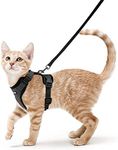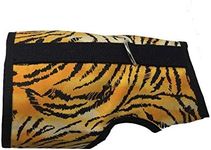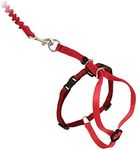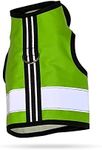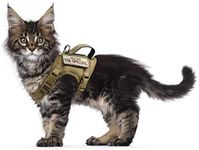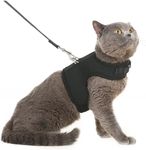Buying Guide for the Best Cat Harnesses
Choosing the right cat harness is important for your cat’s safety, comfort, and your peace of mind when taking your feline friend outdoors. A good harness should fit well, be secure enough to prevent escapes, and be comfortable for your cat to wear. When shopping for a cat harness, it’s important to consider your cat’s size, temperament, and how you plan to use the harness—whether for short walks, travel, or longer outdoor adventures. Understanding the key features will help you make a choice that keeps your cat happy and safe.Harness TypeThe harness type refers to the overall design and structure of the harness. The most common types are H-style, vest-style, and figure-8. H-style harnesses are lightweight and have straps that go around the neck and chest, making them easy to put on but sometimes less secure. Vest-style harnesses cover more of the cat’s body, distributing pressure more evenly and often being harder for cats to escape from, but they can feel bulkier. Figure-8 harnesses are simple and adjustable, but may not be as secure for determined escape artists. If your cat is calm and used to wearing harnesses, a lighter H-style might be fine. For cats new to harnesses or those who tend to wriggle out, a vest-style is usually safer.
MaterialThe material of the harness affects both comfort and durability. Common materials include nylon, mesh, and cotton. Nylon is strong and lightweight, making it a popular choice, but it can sometimes cause chafing if not padded. Mesh harnesses are breathable and comfortable, especially in warm weather, but may not be as durable for very active cats. Cotton is soft and gentle on the skin, but may not be as sturdy as nylon. If your cat has sensitive skin or will wear the harness for long periods, look for soft, padded, or mesh materials. For more active or adventurous cats, durability should be a priority.
AdjustabilityAdjustability refers to how much you can change the size of the harness to fit your cat. Harnesses with multiple adjustable points (such as around the neck and chest) allow for a more customized fit, which is important for both comfort and security. Some harnesses have limited adjustability and may not fit all body shapes well. If your cat is still growing or has a unique body shape, look for a harness with several adjustable straps to ensure a snug but comfortable fit.
Closure TypeClosure type describes how the harness fastens and unfastens. Common closures include buckles, Velcro, and snap fasteners. Buckles are secure and less likely to come undone accidentally, but can be tricky to fasten on a squirmy cat. Velcro is quick and easy to use, but may wear out over time or get clogged with fur. Snap fasteners are convenient but may not be as strong as buckles. If your cat is patient and calm, any closure type can work, but for escape-prone or energetic cats, opt for secure buckles.
Escape-Proof DesignAn escape-proof design means the harness is specifically made to prevent cats from slipping out. This is especially important for cats who are new to harnesses or are known to be escape artists. Features like snug fits, extra straps, or vest styles help keep the harness in place. If your cat is nervous or tends to back out of harnesses, prioritize models that advertise escape-proof features.
Leash Attachment PointThe leash attachment point is where you clip the leash onto the harness. Most harnesses have a D-ring on the back, but some may have additional rings on the chest. The placement affects how pressure is distributed and how much control you have. A back attachment is standard and comfortable for most cats, while a front attachment can help with training or controlling pulling. If you’re just starting out, a simple back attachment is usually sufficient.
SizingSizing is about matching the harness to your cat’s measurements. Harnesses come in different sizes, and it’s important to measure your cat’s neck and chest girth before buying. A harness that’s too loose can be escaped from, while one that’s too tight can be uncomfortable or even harmful. Always check the manufacturer’s sizing chart and, if your cat is between sizes, choose the one that allows for some adjustability.
